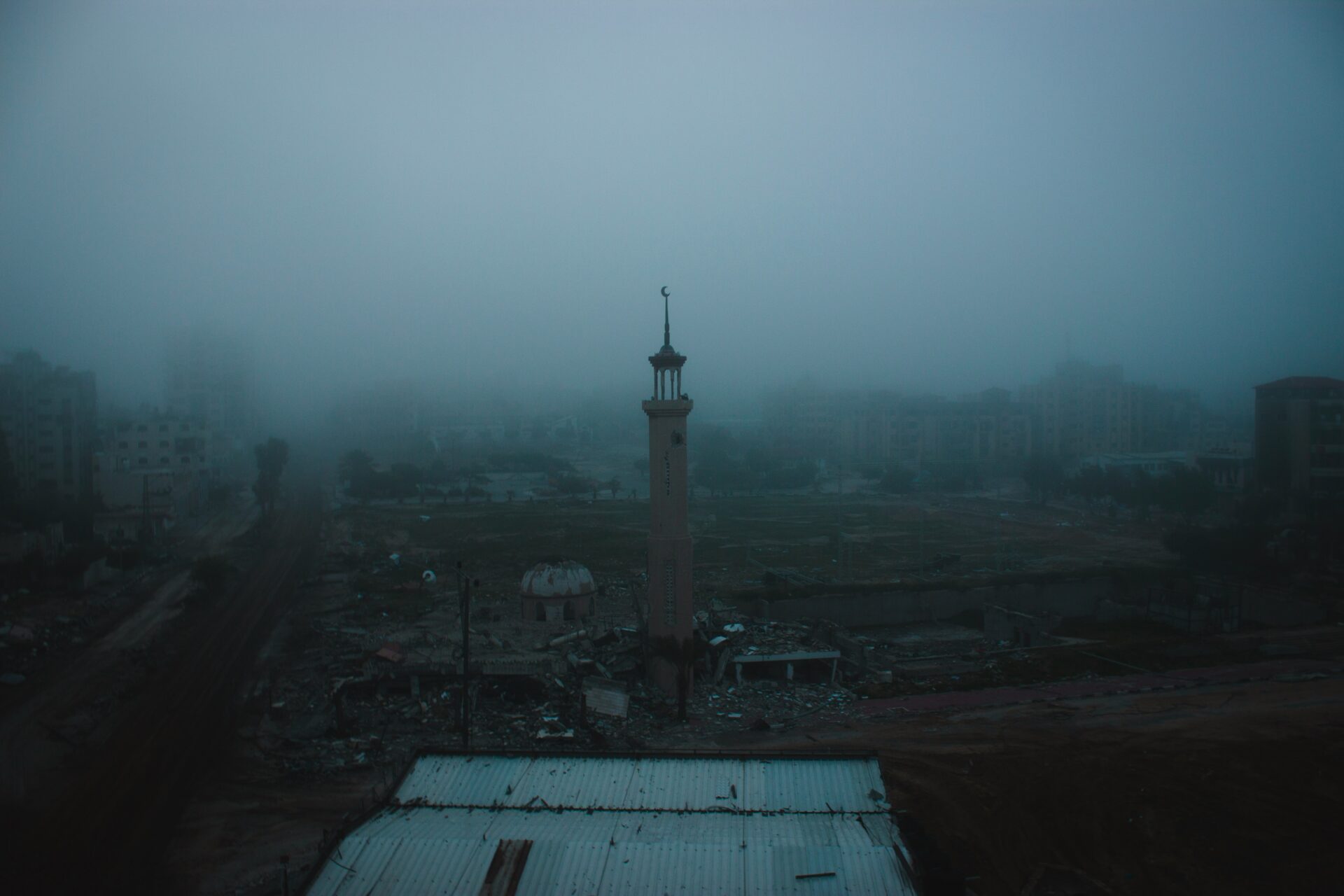With famine spreading across the Gaza Strip, the Nabulsi and Kuwait roundabouts in Gaza City have gone from bustling intersections to sites of death and despair. Local residents and the displaced gather at these spots, hungry and desperate as they wait for northern-bound aid trucks. These gatherings have turned into heartbreaking episodes. As people scramble for basic goods like flour, hoping to nourish their families, attacks have killed scores of civilians.
On the cold morning of Feb. 29, an air of cautious optimism drew thousands to the Nabulsi Roundabout on Harun al-Rashid Street. Whispers of incoming aid had spread like wildfire. For months, the war had reduced many to eating animal feed.
Many in the crowd spotted a convoy at a nearby Israeli checkpoint, heading north. The trucks’ headlights pierced the dark morning. Their lights dimmed, a promise of relief that also sharpened tensions among the desperate people gathered there.
“Turned into Hell”
Salaheddin el-Hashmi later recounted the moment with a heavy heart. “Some of the trucks entered while the lights were off,” he said. “As soon as we approached the trucks to grab a bag of flour, the scene turned into hell.”
On Oct. 7, Hamas-led militants carried out a cross-border attack in Israel, killing some 1,200 and taking around 240 people hostage. Israel quickly launched a full-scale war on the Strip. The fighting has killed more than 31,900 people and injured nearly 74,000. Meanwhile, Palestinians in the Strip face widespread destruction and severe shortages of basic necessities. The has wrought humanitarian crises around the Palestinian enclave, especially in northern Gaza, and pushed many to the brink of starvation.
The conflict has also displaced around 85% of Gazans and damaged or destroyed some 60% of Gaza’s infrastructure, according to the United Nations. Many across the coastal enclave now face acute shortages of food, clean water, and medicine.
Death Traps
El-Hashmi recounted the events of Feb. 29 from a bed at Kamal Adwan Hospital. He said Israeli tanks suddenly appeared. A barrage of gunfire and shelling shattered the fragile hope among the crowd. “The Israeli tanks appeared and started firing and shelling randomly,” he said.
Chaos ensued. El-Hashmi and hundreds of others sought any cover they could find, huddling behind walls. The tanks fired on anyone who tried to approach the aid convoy. “Tens of people were falling around me,” he recalled, his voice trembling.
The tank ran over some people and opened fire on the trucks.
– Salahhedin El-Hashmi
“The tank ran over some people and opened fire on the trucks,” he explained. “As it advanced, it crushed bodies under its treads. Anyone carrying a bag of flour became a target.”
Tank shells were fired, he said. Bursts of machine gun fire sounded off. Israeli forces then methodically combed the area, leaving a trail of devastation in their wake.
As a tactic, turning off the trucks’ lights disoriented civilians and opened them up to ambush, he explained. The tank attack turned the roundabout into a scene of despair and carnage. “It randomly shot people,” he added.
By the time the Feb. 29 attack ended, Israeli fire had killed more than 110 people and injured approximately 110 others, according to Gaza’s health ministry. But it was not a one-off incident. International aid groups have condemned a slate of similar incidents at the Kuwait Roundabout: attacks that killed dozens and injured hundreds.
“Last resort”
As the international community failed to put adequate pressure on Israel to allow the flow of humanitarian aid into the besieged Strip through the Rafah and Kerem Shalom crossing, countries including the United States, Jordan, the United Arab Emirates, and Egypt have taken to airdropping aid into northern Gaza. Those efforts have met the criticism of aid agencies, which deem the method as costly and ineffective.
The World Food Programme (WFP), for instance, has highlighted in the inefficacy of airdrops. On March 6, the WFP pointed out that a failed 14-truck convoy could have brought 200 tons of food. A week’s worth of airdrops, on the other hand, delivered six tons of food.
The agency said on X (formerly Twitter) that airdrops “are only a last resort,” adding: “Road routes are the only way to bring in the large quantities of food desperately needed to avert #famine.”
“Disastrous Process”
The dropped-in aid has symbolized a paradox of despair and desire. In the war-torn neighborhood of Sheikh Radwan, west of Gaza City, 27-year-old Riham Abu Albied has come to dread the sound of aid airdrops. “It is like you have a thread of hope that you will never get,” she said.
Intended as a lifeline, the airdrops often spark chaos and ignite a desperate scramble among the civilians who gather to get aid. Abu Albied’s brother, 30-year-old Yousef, ventured out to get aid for their family during one such drop. “It was a disastrous process, with people pushing and looting from each other,” she said.
Yousef returned from the airdrop injured and with little to show for the risks he took. Now, each time he goes out for aid, it drains him physically and leaves him stripped of his dignity, she explained.
Meanwhile, Abu Albied said, the aid amounts to drop in a ocean and meets only a fraction of the family’s needs. But purchasing food and supplies is hardly a more feasible option. The black market has brought prices to exorbitant levels, leaving the family unable to afford essential goods. “Again, you see the hope, then it flees away from you as these products are sold at insane prices,” she added.
Death from Above
Instances of failed parachute landings have led to fatalities. Abu Albied described a harrowing incident where aid was inadvertently dropped into a Sheikh Radwan pool. This contaminated site posed significant health risks to those daring enough to retrieve the supplies. The consequences were dire, she said, with some falling ill and others narrowly surviving.
In another incident in Shati Refugee Camp, north of Gaza City, the anticipation turned to dread as airdrops descended at a rapid speed due to the malfunctioning of the parachute. Yousef, like many others driven by desperation and hope, made his way to the camp. “A morsel dipped in blood,” he said of the incident. “I wouldn’t have decided to risk my life, but we had no food left.”
As the crowd awaited the aid, Yousef sensed something amiss. He stepped aside. The packages crashed into the camp with devastating force, killing five people and injuring many others. “The scene was utterly like a horror movie,” he said, “but you are part of its tragedy.”
“Propaganda”
Following this tragedy, the government media office in Gaza condemned the airdrops as ineffective, labeling them more “as propaganda than a genuine humanitarian effort.” Authorities in Gaza have called for the opening of land crossings to allow for the safe passage of aid.
But it isn’t just physical harm that people risk while seeking food and other forms of aid. In the face of scarcity, the airdrops have also sewn divisions among the community, pitting neighbors against one another. “Airdrops also result in quarrels that occur between starving families who have turned into militias and gangs,” Abu Albied said.
At the heart of Abu Albied’s experience is a yearning for respect and humanity — a plea for aid to be delivered in a manner that honors the dignity of those it aims to help. “I wish that these airdrops had not happened and that our dignity, freedom, and self-esteem had been taken into consideration,” she added.
“Starvation as a Weapon”
The backdrop of this relentless conflict sees a dire prediction from a UN-backed report, indicating that northern Gaza, where 70% of its populace already endures catastrophic hunger levels, stands on the brink of famine.
The European Union’s foreign policy chief has accused Israel of wielding “starvation as a weapon of war,” with the entire Gaza Strip, home to some 2.2 people, lacking sufficient food. The Integrated Food Security Phase Classification forecasts famine’s onset in northern Gaza as imminent, potentially unfolding between mid-March and May 2024.
As the airdrops have proven inefficient and dangerous, US President Joe Biden has announced plans to construct a temporary pier off Gaza’s coast to facilitate aid delivery — an initiative criticized as merely a diversion from the escalating famine and Israel’s ongoing blockade of the enclave.
For his part, Yousef Albied said, “The world sees and knows all about it, and they allow it to happen.”





















